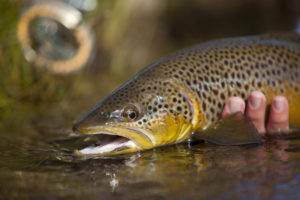
Stealth and focusing on where large trout have cover are the key to success
Low, clear water makes for difficult fly fishing. You can decide to hang up our waders until the next rainfall, or you can embrace the challenge, and develop into a better (more patient) angler. Just as with other aspects of life, the best lessons arise from challenging circumstances. And recent conditions have created a steep learning curve for me.
For example, many of the normal prime spots in a stream become too low to hold large trout, forcing a migration into the deeper pools. This is normal trout behavior anywhere, but I’m amazed to see how few anglers target these pools. And when they do fish these pools, most anglers move fast and try to cover all the water. For years I did the same thing, until I’d spent enough time getting skunked in slow-moving water.
Trout holding in pools during times of low water are on high alert, and any disturbance is going to put these fish down for a while. They’ll develop lockjaw if you get your nymph stuck and try to pop it off the bottom, make a poorly presented cast, or hook a smaller fish that causes commotion during the fight and sends a warning alarm to the larger resident trout.
Of course, you’re going to make some commotion no matter what you do, which means you’re going to spook fish no matter how careful you are. For example, you can make a great dry-fly presentation to the bank, but even when you attempt to quietly lift the line off the water it still makes enough sound to send the fish of the day spooking into the depths. You only had one shot in that area, and now that portion of the stream is shot for the next hour. And that should be your biggest takeaway: you often only get one shot before spooking the resident fish in low water, so you need to identify the most likely holding areas before making a presentation.

Fall time is when you often encounter low water conditions.
For example, there’s one pool I’ve recently been fishing from which I’ve taken some of my largest trout this summer. The pool is approximately 100 yards long, but thereare only five spots along the bank that offer the cover and protection that big trout need. For years, I would just fish all the water in this pool (a.k.a. a shotgun approach) whiling working small grids. Don’t get me wrong, there’s a time and place for working all the water, but low water is not the time. I would catch a few small-to-decent-size fish, but rarely would I land larger trout. That was until I decided to target only the handful of lies from which I’d seen larger trout spook, during my frothing of the water. Instead, I would walk along the banks of the pool and pick just the top four or five targets.
I used a slow, careful wading approach to the first target area, taking as long as five minutes to get into position. This is so important because you need to be in the best position to make a great first cast. Since you rarely get a second chance in these conditions, you need the mindset of a sniper, who only has one chance to make the shot because his target will be alerted by a miss. After getting into position, take an additional minute or two to let the water around you calm down. You’re going to make some commotion no matter how careful we are, and trout will tense up when this happens. So take a few minutes to let the fish relax after you get into position, and then make your perfect presentation.
If the fish doesn’t take on the first cast, try just a few more and then I would advise moving to the next target. This may mean painstakingly taking another five minutes to move just 20 yards upstream. In this 100-yard-long pool, it may take me 30 minutes to make only 10 or 12 casts over the entire reach. I spend more time getting into the perfect casting position than actually making casts.
This requires patience, a trait that I’m only now slowly beginning to develop. This mindset also requires accepting the fact that your rate of success is small, even though you’re going to put a lot of effort into your approach. However, sometimes these efforts will pay off with big trout. Patience has yielded me some of my best low water trout, and I know it will do the same for you.
Written By: George Daniel

